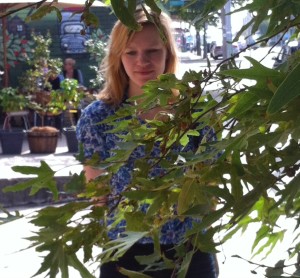
Alison Plevey skipped on stage at 8pm. The crowd, a mottled mix of passers-bys, public servants and young families, took a seat on the scattered crates and tiny foldout chairs. They were ready to watch a performance piece about what is probably the most universally recognised subject on the planet: work.
Created by dance group Lingua Franca in conjunction with Caitlin Welch, Yohan Iddawela and Adam Deusien, Work It was a performative art piece bringing together dance, video and music. The piece aimed to explore our relationship to the modern day workplace by reflecting on behaviours, thoughts and feelings connected with work.
Plevey danced on stage while a video projection on the wall behind her rolled through the stories of seven different people (the workers) who spoke about the practicalities of their job. Among the stories were those of a human rights lawyer, a hospitality worker, a gardener, a mental health worker, a chef, a hairdresser and finally, a mother. In the background, a playlist with a heavy bass led the audience through each worker’s day-to-day existence.
Plevey transformed herself across the stage, executing a skilfully choreographed routine that melded with the stories of the workers by recreating their experience of life at work. At times, Plevey was anxious and frantic, clutching at papers and flitting about, recreating the atmosphere of pressure and stress associated with the day-to-day work of a human rights lawyer. Later in the piece, Plevey became playful, her movements mimicking the mother’s small children.
As powerful as Plevey’s performance was, its impact was, at times, diluted on the Garema Place stage. Viewers could not connect with the performance because the stage was too exposed. Whilst the piece was intended to be viewed as a whole, many audience members drifted in and out of the performance due to the open nature of the venue. There was also the trouble of general distractions in an open venue in the middle of Canberra’s city centre, which was busy on a Friday evening. At one point in the performance, two audience members got up and started dancing and yelling, obscuring the view for the rest of the audience.
Despite this, the performance was inspiring. Plevey’ s finely tuned choreography and the accompanying playlist was an expression of the more inspiring and positive aspects of the work in which we are all engaged at one time or another.
– by Rosy Listing
 Rosy Listing is a writer/arts reviewer/lawyer from Canberra. She finished her arts degree majoring in art history at ANU, and her law degree whilst studying in England and at Sydney University. She is a lawyer by day, and practices writing by night. A self-confessed art enthusiast, Rosy has written for arts publications MusiqueArt – a street magazine in Sydney, and the academic publication – Art Antiquity and Law. She currently hones her writing and reviewing skills through online blogs and by reviewing local arts events around Canberra.
Rosy Listing is a writer/arts reviewer/lawyer from Canberra. She finished her arts degree majoring in art history at ANU, and her law degree whilst studying in England and at Sydney University. She is a lawyer by day, and practices writing by night. A self-confessed art enthusiast, Rosy has written for arts publications MusiqueArt – a street magazine in Sydney, and the academic publication – Art Antiquity and Law. She currently hones her writing and reviewing skills through online blogs and by reviewing local arts events around Canberra.


Trackbacks/Pingbacks
[…] Rosy Listing is a writer/arts reviewer/lawyer from Canberra. She finished her arts degree majoring in art history at ANU, and her law degree whilst studying in England and at Sydney University. She is a lawyer by day, and practices writing by night. A self-confessed art enthusiast, Rosy has written for arts publications MusiqueArt – a street magazine in Sydney, and the academic publication – Art Antiquity and Law. She currently hones her writing and reviewing skills through online blogs and by reviewing local arts events around Canberra. – See more at: http://buzzcuts.org.au/2015/03/review-work-it/#sthash.OCnQGPor.dpuf […]